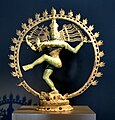Rietberg Museum

The Rietberg Museum is a museum in Zürich, Switzerland, displaying Asian, African, American and Oceanian art. It is the largest art museum focusing on non-European art and design in Switzerland, the third-largest museum in Zürich, and the largest to be run by the city itself. In 2007, it received approximately 157,000 visitors.
Location and buildings
The Rietberg Museum is situated in the Rieterpark in Zürich, and consists of several historic buildings: the Wesendonck Villa, the Remise (or "Depot"), the Rieter Park-Villa, and the Schönberg Villa. In 2007 a new building known as "Smaragd" was opened, designed by Alfred Grazioli and Adolf Krischanitz. The addition of this largely subterranean building more than doubled the museum's exhibition space.[1][2][3]
The museum is located near Zürich Enge railway station, and can also be reached by tram line #7 and bus line #33.
History
In the early 1940s, the city of Zürich purchased the Rieterpark and the Wesendonck Villa. In 1949, the villa was selected, by referendum, to be rebuilt into a museum for the art collection of Baron von der Heydt which he had donated to the city in 1945.[3] This was carried out in 1951-52 under the architect Alfred Gradmann. The Rietberg Museum was opened on 24 May 1952. Johannes Itten, the Swiss expressionist painter, was director of the museum until 1956.
In 1976, the city acquired the Schönberg Villa, which had been threatened with demolition, and opened it in 1978 as an extension of the museum. Today, the villa is also home to an extensive non-lending library administrated by the museum.
Organisation and funding
The Rietberg Museum is operated by the presidential department of the city of Zürich. In 2007, it employed around one hundred people. About half of the funding comes from the city, while the other half is raised through revenue, sponsors,[4] and donations. Additions to the collection come mostly from donations.
Publishing activities
The museum established an in-house press shortly after its founding in 1952. Initially, it published catalogues of the museum's Asian and African artworks, as well as occasional short monographs. The museum's publishing activity has increased since 1985, in connection with the large special exhibitions that it has organised since then, and it now publishes around five new titles per year.[5][6]
Since 1991, the museum also publishes Artibus Asiae, a biannual scholarly journal on the arts and archaeology of Asia.
Sculpture
-
Exhibition room in the Wesendonck Villa
-
Exhibition room in the Wesendonck Villa
-
In the Depot
-
pair of figures, Egypt, Fifth Dynasty, c. 2400 BCE
-
Votive stele withBuddha Shakyamuni, China, Eastern Wei Dynasty, c. 536 CE
-
Acala, king of the mystical knowledge; Japan, Fujiwara clan, 12th century
-
Shiva Nataraja, Chola dynasty, 12th century
-
Idol ofTīrthankara, India, 14th century
-
Carved elephant tusk,Benin Empire, Nigeria, 17-18th Century
Painting
-
A Monk is Greeted at the Gate of the Coronation Hall. Folio from a Kalpasutra Manuscript. India, ca. 1475.
-
Nanquan Puyuan kills a cat by Shōkei Kenkō. Japan, 1495
-
Krishna and Balarama Taking the Cattle to Graze. Folio from a Bhagavata Purana Manuscript. India, 1520-40
-
Shepherds and nobles welcome a mounted prince and princess. Attributed to Muhammad Qasem. Isfahan, ca. 1648
-
The Devi Rides in State. Folio from a Devi series attributed to Kripal of Nurpur. Nurpur, c. 1670
-
Thousand peaks and ten thousand valleys by Gong Xian. China, c. 1670
-
Raga Madhava, by the 2nd Master of the Shangri Ramayana series. Probably Bahu, c. 1720
-
Varaha and Hiranyaksha. Folio from a Bhagavata Purana Series by Manaku of Guler. Guler, c. 1740
-
Ragini Madhumadhavi, by Jay Krishna. Malpura, c. 1756
-
Re-Enacting Krishna's marvellous Deeds, Folio from the Bhagavata Purana series ascribed to a Master of the first generation after Manaku and Nainsukh. India, c. 1780-1785
References
- ^ Museum Rietberg. Die Erweiterung Archived 2011-09-27 at the Wayback Machine City of Zürich. (in German)
- ^ Erweiterung Museum Rietberg in Zürich/CH BauNetz. (in German)
- ^ a b Museum Rietberg in Zürich Archived 2011-07-18 at the Wayback Machine Hubertus Adam, Bauwelt 17, 2007. (in German)
- ^ Sponsoring[permanent dead link] City of Zürich. (in German)
- ^ Verlag Museum Rietberg[permanent dead link] City of Zürich. (in German)
- ^ List of publications by the Rietberg Museum's press Katalog der Deutschen Nationalbibliothek. (in German)
























